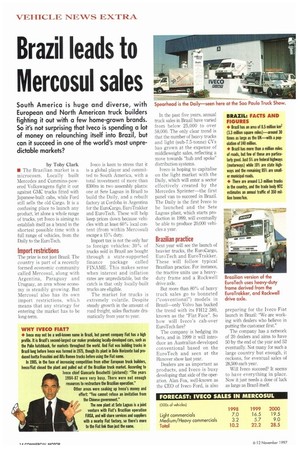Brazil leads to Mercosul sales
Page 16

If you've noticed an error in this article please click here to report it so we can fix it.
South America is huge and diverse, with European and North American truck builders fighting it out with a few home-grown brands. So it's not surprising that Iveco is spending a lot of money on relaunching itself into Brazil, but can it succeed in one of the world's most unpredictable markets?
by Toby Clark • The Brazilian market is a microcosm. Locally built Mercedes and Cummins-powered Volkswagens fight it out against GMC trucks fitted with Japanese-built cabs, while Ford still sells the old Cargo. It is a confusing place to launch any product, let alone a whole range of trucks, yet Iveco is aiming to establish itself as a brand in the shortest possible time with a full range of vehicles, from the Daily to the EuroTech.
Import restrictions
The prize is not just Brazil. The country is part of a recently formed economic community called Mercosul, along with Argentina, Paraguay and Uruguay, an area whose economy is steadily growing. But Mercosul also has its own import restrictions, whic.11 means that any strategy for entering the market has to be long-term. lveco is keen to stress that it is a global player and committed to South America, with a total investment of more than $300m in two assembly plants: one at Sete Lagoas in Brazil to build the Daily, and a rebuilt factory at Cordoba in Argentina for the EuroCargo, EuroTrakker and EuroTech. These will help keep prices down because vehicles with at least 60% local content (from within Mercosul) escape a 15% duty.
Import tax is not the only bar to foreign vehicles: 30% of trucks sold in Brazil are bought through a state-supported finance package called FINAME. This makes sense when interest and inflation rates are unpredictable, but the catch is that only locally-built trucks are eligible.
The market for trucks is extremely volatile. Despite steady growth in the amount of road freight, sales fluctuate dramatically from year to year. In the past five years, annual truck sales in Brazil have varied from below 25,000 to over 58,000. The only clear trend is that the number of heavy trucks and light (sub-7.5-tonne) CVs has grown at the expense of middleweight sales, reflecting a move towards "hub and spoke" distribution systems.
Iveco is hoping to capitalise on the light market with the Daily, which will enter a sector effectively created by the Mercedes Sprinter—the first panel van to succeed in Brazil. The Daily is the first Iveco to be launched and the Sete Lagoas plant, which starts production in 1999, will eventually be able to produce 20,000 vehicles a year.
Brazilian practice
Next year will see the launch of heavier trucks, the EuroCargo, EuroTech and EuroTrakker. These will follow typical Brazilian practice. For instance, the tractive units use a heavyduty frame and a Rockwell drive axle.
But more than 80% of heavy truck sales go to bonneted ("conventional") models in Brazil—only Volvo has bucked the trend with its FH12 380, known as the "Flat Face". So how will Iveco's cab-over EuroTech fare?
The company is hedging its bets, and in 1999 it will introduce an Australian-developed conventional based on the EuroTech and seen at the Hanover show last year.
Dealers are as important as products, and Iveco is busy developing that side of the operation. Alan Fox, well-known as the CEO of Iveco Ford. is also preparing for the Iveco Fiat launch in Brazil: "We are working with dealers who believe in putting the customer first."
The company has a network of 20 dealers and aims to have 50 by the end of the year and 52 eventually. Not many for such a large country but enough, it reckons, for eventual sales of 28,500 each year.
Will Iveco succeed? It seems to have everything in place. Now it just needs a dose of luck as large as Brazil itself. WHY IVECO FIAT?
• leen may not be a well-known name in Brazil, but parent company Fiat has a high profile. It is Brazil's second-largest car maker producing locally-developed cars, such as the Palio hatchback, for markets throughout the world. And Fiat was building trucks in Brazil long before Inca was formed in 1975, though its plant in Belo Horizonte had produced Isotta Fraschini and Alfa Romeo trucks before using the Fiat name.
In 1985. in the face of increasing competition from other European truck builders, Iveco/Fiat closed the plant and pulled out of the Brazilian truck market. According to lveco chief Giancarlo Boschetti (pictured): The years 1984-87 were very busy. There were not enough resources to restructure the Brazilian operation."
Other areas were soaking up Iveco's money and effort You cannot refuse an invitation from the Chinese government."
The new plant at Sete Lagoas is a joint venture with Fiat's Brazilian operation FIASA, and will share services and suppliers with a nearby Fiat factory, so there's more to the Fiat link than just the name.
BRAZIL: FACTS AND FIGURES • Brazil has an area of 8.5 million km2 (3.3 million square miles)—around 30 times as large as the UK—with a population of 140 million.
• Brazil has more than a million miles of roads, but few of these are particularly good. lust 5-/) are federal highways (motorways) while 10°I. are state highways and the remaining 85-/: are smaller municipal roads.
• There are around 1.3 radon trucks in the country, and the trade body NTC estimates an annual traffic of 350 milhon tonne/km.




















































































































